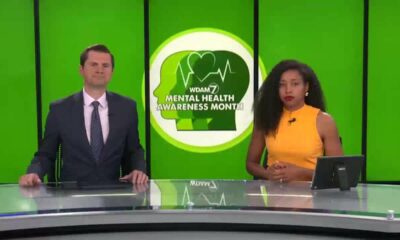Kaiser Health News
Horse Sedative Use Among Humans Spreads in Deadly Mixture of ‘Tranq’ and Fentanyl
Sam Ogozalek, Tampa Bay Times
Mon, 26 Feb 2024 10:00:00 +0000
TREASURE ISLAND, Fla. — Andrew McClave Jr. loved to lift weights. The 6-foot-4-inch bartender resembled a bodybuilder and once posed for a photo flexing his muscles with former pro wrestler Hulk Hogan.
“He was extremely dedicated to it,” said his father, Andrew McClave Sr., “to the point where it was almost like he missed his medication if he didn't go.”
But the hobby took its toll. According to a police report, a friend told the Treasure Island Police Department that McClave, 36, suffered from back problems and took unprescribed pills to reduce the pain.
In late 2022, the friend discovered McClave in bed. He had no pulse. A medical examiner determined he had a fatal amount of fentanyl, cocaine, and xylazine, a veterinary tranquilizer used to sedate horses, in his system, an autopsy report said. Heart disease was listed as a contributing factor.
McClave is among more than 260 people across Florida who died in one year from accidental overdoses involving xylazine, according to a Tampa Bay Times analysis of medical examiner data from 2022, the first year state officials began tracking the substance. Numbers for 2023 haven't been published.
The death toll reflects xylazine's spread into the nation's illicit drug supply. Federal regulators approved the tranquilizer for animals in the early 1970s and it's used to sedate horses for procedures like oral exams and colic treatment, said Todd Holbrook, an equine medicine specialist at the University of Florida. Reports of people using xylazine emerged in Philadelphia, then the drug spread south and west.
What's not clear is exactly what role the sedative plays in overdose deaths, because the Florida data shows no one fatally overdosed on xylazine alone. The painkiller fentanyl was partly to blame in all but two cases in which the veterinary drug was included as a cause of death, according to the Times analysis. Cocaine or alcohol played roles in the cases in which fentanyl was not involved.
Fentanyl is generally the “800-pound gorilla,” according to Lewis Nelson, chair of the emergency medicine department at Rutgers New Jersey Medical School, and xylazine may increase the risk of overdose, though not substantially.
But xylazine appears to complicate the response to opioid overdoses when they do happen and makes it harder to save people. Xylazine can slow breathing to dangerous levels, according to federal health officials, and it doesn't respond to the overdose reversal drug naloxone, often known by the brand name Narcan. Part of the problem is that many people may not know they are taking the horse tranquilizer when they use other drugs, so they aren't aware of the additional risks.
Lawmakers in Tallahassee made xylazine a Schedule 1 drug like heroin or ecstasy in 2016, and several other states including Pennsylvania, Ohio, and West Virginia have taken action to classify it as a scheduled substance, too. But it's not prohibited at the federal level. Legislation pending in Congress would criminalize illicit xylazine use nationwide.
The White House in April designated the combination of fentanyl and xylazine, often called “tranq dope,” as an emerging drug threat. A study of 20 states and Washington, D.C., found that overdose deaths attributed to both illicit fentanyl and xylazine exploded from January 2019 to June 2022, jumping from 12 a month to 188.
“We really need to continue to be proactive,” said Amanda Bonham-Lovett, program director of a syringe exchange in St. Petersburg, “and not wait until this is a bigger issue.”
‘A Good Business Model'
There are few definitive answers about why xylazine use has spread — and its impact on people who consume it.
The U.S. Drug Enforcement Administration in September said the tranquilizer is entering the country in several ways, including from China and in fentanyl brought across the southwestern border. The Florida attorney general's office is prosecuting an Orange County drug trafficking case that involves xylazine from a New Jersey supplier.
Bonham-Lovett, who runs IDEA Exchange Pinellas, the county's anonymous needle exchange, said some local residents who use drugs are not seeking out xylazine — and don't know they're consuming it.
One theory is that dealers are mixing xylazine into fentanyl because it's cheap and also affects the brain, Nelson said.
“It's conceivable that if you add a psychoactive agent to the fentanyl, you can put less fentanyl in and still get the same kick,” he said. “It's a good business model.”
In Florida, men accounted for three-quarters of fatal overdoses involving xylazine, according to the Times analysis. Almost 80% of those who died were white. The median age was 42.
Counties on Florida's eastern coast saw the highest death tolls. Duval County topped the list with 46 overdoses. Tampa Bay recorded 19 fatalities.
Cocaine was also a cause in more than 80 cases, including McClave's, the Times found. The DEA in 2018 warned of cocaine laced with fentanyl in Florida.
In McClave's case, Treasure Island police found what appeared to be marijuana and a small plastic bag with white residue in his room, according to a police report. His family still questions how he took the powerful drugs and is grappling with his death.
He was an avid fisherman, catching snook and grouper in the Gulf of Mexico, said his sister, Ashley McClave. He dreamed of being a charter boat captain.
“I feel like I've lost everything,” his sister said. “My son won't be able to learn how to fish from his uncle.”
Mysterious Wounds
Another vexing challenge for health officials is the link between chronic xylazine use and open wounds.
The wounds are showing up across Tampa Bay, needle exchange leaders said. The telltale sign is blackened, crusty tissue, Bonham-Lovett said. Though the injuries may start small — the size of a dime — they can grow and “take over someone's whole limb,” she said.
Even those who snort fentanyl, instead of injecting it, can develop them. The phenomenon is unexplained, Nelson said, and is not seen in animals.
IDEA Exchange Pinellas has recorded at least 10 cases since opening last February, Bonham-Lovett said, and has a successful treatment plan. Staffers wash the wounds with soap and water, then dress them.
One person required hospitalization partly due to xylazine's effects, Bonham-Lovett said. A 31-year-old St. Petersburg woman, who asked not to be named due to concerns over her safety and the stigma of drug use, said she was admitted to St. Anthony's Hospital in 2023. The woman, who said she uses fentanyl daily, had a years-long staph infection resistant to some antibiotics, and a wound recently spread across half her thigh.
The woman hadn't heard of xylazine until IDEA Exchange Pinellas told her about the drug. She's thankful she found out in time to get care.
“I probably would have lost my leg,” she said.
This article was produced in partnership with the Tampa Bay Times.
——————————
By: Sam Ogozalek, Tampa Bay Times
Title: Horse Sedative Use Among Humans Spreads in Deadly Mixture of ‘Tranq' and Fentanyl
Sourced From: kffhealthnews.org/news/article/horse-sedative-tranq-fentanyl-deadly/
Published Date: Mon, 26 Feb 2024 10:00:00 +0000
Did you miss our previous article…
https://www.biloxinewsevents.com/california-gov-newsom-wants-voters-to-approve-billions-more-to-help-the-homeless-will-it-help/
Kaiser Health News
KFF Health News’ ‘What the Health?’: Bird Flu Lands as the Next Public Health Challenge
Thu, 16 May 2024 18:30:00 +0000
The Host
Julie Rovner
KFF Health News
Julie Rovner is chief Washington correspondent and host of KFF Health News' weekly health policy news podcast, “What the Health?” A noted expert on health policy issues, Julie is the author of the critically praised reference book “Health Care Politics and Policy A to Z,” now in its third edition.
Public health officials are watching with concern since a strain of bird flu spread to dairy cows in at least nine states, and to at least one dairy worker. But in the wake of covid-19, many farmers are loath to let in health authorities for testing.
Meanwhile, another large health company — the Catholic hospital chain Ascension — has been targeted by a cyberattack, leading to serious problems at some facilities.
This week's panelists are Julie Rovner of KFF Health News, Rachel Cohrs Zhang of Stat, Alice Miranda Ollstein of Politico, and Sandhya Raman of CQ Roll Call.
Panelists
Rachel Cohrs Zhang
Stat News
Alice Miranda Ollstein
Politico
Sandhya Raman
CQ Roll Call
Among the takeaways from this week's episode:
- Stumbles in the early response to bird flu bear an uncomfortable resemblance to the early days of covid, including the troubles protecting workers who could be exposed to the disease. Notably, the Department of Agriculture benefited from millions in covid relief funds designed to strengthen disease surveillance.
- Congress is working to extend coverage of telehealth care; the question is, how to pay for it? Lawmakers appear to have settled on a two-year agreement, though more on the extension — including how much it will cost — remains unknown.
- Speaking of telehealth, a new report shows about 20% of medication abortions are supervised via telehealth care. State-level restrictions are forcing those in need of abortion care to turn to options farther from home.
- And new reporting on Medicaid illuminates the number of people falling through the cracks of the government health system for low-income and disabled Americans — including how insurance companies benefit from individuals' confusion over whether they have Medicaid coverage at all.
Also this week, Rovner interviews Atul Grover of the Association of American Medical Colleges about its recent analysis showing that graduating medical students are avoiding training in states with abortion bans and major restrictions.
Plus, for “extra credit,” the panelists suggest health policy stories they read this week that they think you should read, too:
Julie Rovner: NPR's “Why Writing by Hand Beats Typing for Thinking and Learning,” by Jonathan Lambert.
Alice Miranda Ollstein: Time's “‘I Don't Have Faith in Doctors Anymore.' Women Say They Were Pressured Into Long-Term Birth Control,” by Alana Semuels.
Rachel Cohrs Zhang: Stat's “After Decades Fighting Big Tobacco, Cliff Douglas Now Leads a Foundation Funded by His Former Adversaries,” by Nicholas Florko.
Sandhya Raman: The Baltimore Banner's “People With Severe Mental Illness Are Stuck in Jail. Montgomery County Is the Epicenter of the Problem,” by Ben Conarck.
Also mentioned on this week's podcast:
- Stat's “My Rendezvous With the Raw Milk Black Market: Quick, Easy, and Unchecked by the FDA,” by Nicholas Florko.
- The Stamford Advocate's “Dan Haar: Hackers Stole a Disabled CT Couple's SNAP Food Aid. Now They're Out $1,373,” by Dan Haar.
- WKRN's “‘Chaos': Nurses, Visitors Describe Conditions Inside Ascension Hospitals After Cyberattack,” by Stephanie Langston.
- KFF Health News' “Medicaid ‘Unwinding' Decried as Biased Against Disabled People,” by Daniel Chang.
- KFF Health News' “Why Medicaid's ‘Undercount' Problem Counts,” by Phil Galewitz.
Credits
Francis Ying
Audio producer
Emmarie Huetteman
Editor
To hear all our podcasts, click here.
And subscribe to KFF Health News' “What the Health?” on Spotify, Apple Podcasts, Pocket Casts, or wherever you listen to podcasts.
——————————
Title: KFF Health News' ‘What the Health?': Bird Flu Lands as the Next Public Health Challenge
Sourced From: kffhealthnews.org/news/podcast/what-the-health-347-bird-flu-next-public-health-challenge-may-16-2024/
Published Date: Thu, 16 May 2024 18:30:00 +0000
Kaiser Health News
California’s $12 Billion Medicaid Makeover Banks on Nonprofits’ Buy-In
Angela Hart
Thu, 16 May 2024 09:00:00 +0000
TURLOCK, Calif. — For much of his young life, Jorge Sanchez regularly gasped for air, at times coughing so violently that he'd almost throw up. His mother whisked him to the emergency room late at night and slept with him to make sure he didn't stop breathing.
“He's had these problems since he was born, and I couldn't figure out what was triggering his asthma,” Fabiola Sandoval said of her son, Jorge, now 4. “It's so hard when your child is hurting. I was willing to try anything.”
In January, community health workers visited Sandoval's home in Turlock, a city in California's Central Valley where dust from fruit and nut orchards billows through the air. They scoured Sandoval's home for hazards and explained that harsh cleaning products, air fresheners, and airborne dust and pesticides can trigger an asthma attack.
The team also provided Sandoval with air purifiers, a special vacuum cleaner that can suck dust out of the air, hypoallergenic mattress covers, and a humidity sensor — goods that retail for hundreds of dollars. Within a few months, Jorge was breathing easier and was able to run and play outside.
The in-home consultation and supplies were paid for by Medi-Cal, California's Medicaid health insurance program for low-income residents. Gov. Gavin Newsom is spearheading an ambitious $12 billion experiment to transform Medi-Cal into both a health insurer and a social services provider, one that relies not only on doctors and nurses, but also community health workers and nonprofit groups that offer dozens of services, including delivering healthy meals and helping homeless people pay for housing.
These groups are redefining health care in California as they compete with businesses for a share of the money, and become a new arm of the sprawling Medi-Cal bureaucracy that serves nearly 15 million low-income residents on an annual budget of $158 billion.
But worker shortages, negotiations with health insurance companies, and learning to navigate complex billing and technology systems have hamstrung the community groups' ability to deliver the new services: Now into the third year of the ambitious five-year experiment, only a small fraction of eligible patients have received benefits.
“This is still so new, and everyone is just overwhelmed at this point, so it's slow-going,” said Kevin Hamilton, a senior director at the Central California Asthma Collaborative.
The collaborative has served about 3,650 patients, including Sandoval, in eight counties since early 2022, he said. It has years of experience with Medi-Cal patients in the Central Valley and has received about $1.5 million of the new initiative's money.
By contrast, CalOptima Health, Orange County's primary Medi-Cal insurer, is new to offering asthma benefits and has signed up 58 patients so far.
“Asthma services are so difficult to get going” because the nonprofit infrastructure for these services is virtually nonexistent, said Kelly Bruno-Nelson, CalOptima's executive director for Medi-Cal. “We need more community-based organizations on board because they're the ones who can serve a population that nobody wants to deal with.”
Newsom, a Democrat in his second term, says his signature health care initiative, known as CalAIM, seeks to reduce the cost of caring for the state's sickest and most vulnerable patients, including homeless Californians, foster children, former inmates, and people battling addiction disorders.
In addition to in-home asthma remediation, CalAIM offers 13 broad categories of social services, plus a benefit connecting eligible patients with one-on-one care managers to help them obtain anything they need to get healthier, from grocery shopping to finding a job.
The 25 managed-care insurance companies participating in Medi-Cal can choose which services they offer, and contract with community groups to provide them. Insurers have hammered out about 4,300 large and small contracts with nonprofits and businesses.
So far, about 103,000 Medi-Cal patients have received CalAIM services and roughly 160,000 have been assigned personal care managers, according to state data, a sliver of the hundreds of thousands of patients who likely qualify.
“We're all new to health care, and a lot of this is such a foreign concept,” said Helena Lopez, executive director of A Greater Hope, a nonprofit organization providing social services in Riverside and San Bernardino counties, such as handing out baseball cleats to children to help them be active.
Tiffany Sickler runs Koinonia Family Services, which offers California foster children mental health and other types of care, and even helped a patient pay off parking tickets. But the program is struggling on a shoestring budget.
“If you want to do this, you have to learn all these new systems. It's been a huge learning curve, and very time-consuming and frustrating, especially without adequate funding,” she said.
Brandon Richards, a Newsom spokesperson, defended CalAIM, saying that it was “on the cutting edge of health care” and that the state was working to increase “awareness of these new services and support.”
For nonprofits and businesses, CalAIM is a money-making opportunity — one that top state health officials hope to make permanent. Health insurers, which receive hefty payments from the state to serve more people and offer new services, share a portion with service providers.
In some places, community groups are competing with national corporations for the new funding, such as Mom's Meals, an Iowa-based company that delivers prepared meals across the United States.
Mom's Meals has an advantage over neighborhood nonprofit groups because it has long served seniors on Medicare and was able to immediately start offering the CalAIM benefit of home-delivered meals for patients with chronic diseases. But even Mom's Meals isn't reaching everyone who qualifies, because doctors and patients don't always know it's an option, said Catherine Macpherson, the company's chief nutrition officer.
“Utilization is not as high as it should be yet,” she said. “But we were well positioned, because we already had departments to do billing and contracting with health care.”
Middleman companies also have their eye on the billions of CalAIM dollars and are popping up to assist small organizations to go up against established ones like Mom's Meals. For instance, the New York-based Nonprofit Finance Fund is advising homeless service providers how to get more contracts and expand benefits.
Full Circle Health Network, with 70 member organizations, is helping smaller nonprofit groups develop and deliver services primarily for families and foster children. Full Circle has signed a deal with Kaiser Permanente, allowing the health care giant to access its network of community groups.
“We're allowing organizations to launch these benefits much faster than they've been able to do and to reach more vulnerable people,” said Camille Schraeder, chief executive of Full Circle. “Many of these are grassroots organizations that have the trust and expertise on the ground, but they're new to health care.”
One of the biggest challenges community groups face is hiring workers, who are key to finding eligible patients and persuading them to participate.
Kathryn Phillips, a workforce expert at the California Health Care Foundation, said there isn't enough seed money for community groups to hire workers and pay for new technology platforms. “They bring the trust that is needed, the cultural competency, the diversity of languages,” she said. “But there needs to be more funding and reimbursement to build this workforce.”
Health insurers say they are trying to increase the workforce. For instance, L.A. Care Health Plan, the largest Medi-Cal insurer in California, has given $66 million to community organizations for hiring and other CalAIM needs, said Sameer Amin, the group's chief medical officer.
“They don't have the staffing to do all this stuff, so we're helping with that all while teaching them how to build up their health care infrastructure,” he said. “Everyone wants a win, but this isn't going to be successful overnight.”
In the Central Valley, Jorge Sanchez is one of the lucky early beneficiaries of CalAIM.
His mother credits the trust she established with community health workers, who spent many hours over multiple visits to teach her how to control her son's asthma.
“I used to love cleaning with bleach” but learned it can trigger breathing problems, Sandoval said.
Since she implemented the health workers' recommendations, Sandoval has been able to let Jorge sleep alone at night for the first time in four years.
“Having this program and all the things available is amazing,” said Sandoval, as she pointed to the dirty dust cup in her new vacuum cleaner. “Now my son doesn't have as many asthma attacks and he can run around and be a normal kid.”
This article was produced by KFF Health News, which publishes California Healthline, an editorially independent service of the California Health Care Foundation.
——————————
By: Angela Hart
Title: California's $12 Billion Medicaid Makeover Banks on Nonprofits' Buy-In
Sourced From: kffhealthnews.org/news/article/newsom-medicaid-12-billion-dollar-makeover-nonprofits-bureacracy-calaim/
Published Date: Thu, 16 May 2024 09:00:00 +0000
Kaiser Health News
Federal Panel Prescribes New Mental Health Strategy To Curb Maternal Deaths
Cheryl Platzman Weinstock
Thu, 16 May 2024 09:00:00 +0000
For help, call or text the National Maternal Mental Health Hotline at 1-833-TLC-MAMA (1-833-852-6262) or contact the 988 Suicide & Crisis Lifeline by dialing or texting “988.” Spanish-language services are also available.
BRIDGEPORT, Conn. — Milagros Aquino was trying to find a new place to live and had been struggling to get used to new foods after she moved to Bridgeport from Peru with her husband and young son in 2023.
When Aquino, now 31, got pregnant in May 2023, “instantly everything got so much worse than before,” she said. “I was so sad and lying in bed all day. I was really lost and just surviving.”
Aquino has lots of company.
Perinatal depression affects as many as 20% of women in the United States during pregnancy, the postpartum period, or both, according to studies. In some states, anxiety or depression afflicts nearly a quarter of new mothers or pregnant women.
Many women in the U.S. go untreated because there is no widely deployed system to screen for mental illness in mothers, despite widespread recommendations to do so. Experts say the lack of screening has driven higher rates of mental illness, suicide, and drug overdoses that are now the leading causes of death in the first year after a woman gives birth.
“This is a systemic issue, a medical issue, and a human rights issue,” said Lindsay R. Standeven, a perinatal psychiatrist and the clinical and education director of the Johns Hopkins Reproductive Mental Health Center.
Standeven said the root causes of the problem include racial and socioeconomic disparities in maternal care and a lack of support systems for new mothers. She also pointed a finger at a shortage of mental health professionals, insufficient maternal mental health training for providers, and insufficient reimbursement for mental health services. Finally, Standeven said, the problem is exacerbated by the absence of national maternity leave policies, and the access to weapons.
Those factors helped drive a 105% increase in postpartum depression from 2010 to 2021, according to the American Journal of Obstetrics & Gynecology.
For Aquino, it wasn't until the last weeks of her pregnancy, when she signed up for acupuncture to relieve her stress, that a social worker helped her get care through the Emme Coalition, which connects girls and women with financial help, mental health counseling services, and other resources.
Mothers diagnosed with perinatal depression or anxiety during or after pregnancy are at about three times the risk of suicidal behavior and six times the risk of suicide compared with mothers without a mood disorder, according to recent U.S. and international studies in JAMA Network Open and The BMJ.
The toll of the maternal mental health crisis is particularly acute in rural communities that have become maternity care deserts, as small hospitals close their labor and delivery units because of plummeting birth rates, or because of financial or staffing issues.
This week, the Maternal Mental Health Task Force — co-led by the Office on Women's Health and the Substance Abuse and Mental Health Services Administration and formed in September to respond to the problem — recommended creating maternity care centers that could serve as hubs of integrated care and birthing facilities by building upon the services and personnel already in communities.
The task force will soon determine what portions of the plan will require congressional action and funding to implement and what will be “low-hanging fruit,” said Joy Burkhard, a member of the task force and the executive director of the nonprofit Policy Center for Maternal Mental Health.
Burkhard said equitable access to care is essential. The task force recommended that federal officials identify areas where maternity centers should be placed based on data identifying the underserved. “Rural America,” she said, “is first and foremost.”
There are shortages of care in “unlikely areas,” including Los Angeles County, where some maternity wards have recently closed, said Burkhard. Urban areas that are underserved would also be eligible to get the new centers.
“All that mothers are asking for is maternity care that makes sense. Right now, none of that exists,” she said.
Several pilot programs are designed to help struggling mothers by training and equipping midwives and doulas, people who provide guidance and support to the mothers of newborns.
In Montana, rates of maternal depression before, during, and after pregnancy are higher than the national average. From 2017 to 2020, approximately 15% of mothers experienced postpartum depression and 27% experienced perinatal depression, according to the Montana Pregnancy Risk Assessment Monitoring System. The state had the sixth-highest maternal mortality rate in the country in 2019, when it received a federal grant to begin training doulas.
To date, the program has trained 108 doulas, many of whom are Native American. Native Americans make up 6.6% of Montana's population. Indigenous people, particularly those in rural areas, have twice the national rate of severe maternal morbidity and mortality compared with white women, according to a study in Obstetrics and Gynecology.
Stephanie Fitch, grant manager at Montana Obstetrics & Maternal Support at Billings Clinic, said training doulas “has the potential to counter systemic barriers that disproportionately impact our tribal communities and improve overall community health.”
Twelve states and Washington, D.C., have Medicaid coverage for doula care, according to the National Health Law Program. They are California, Florida, Maryland, Massachusetts, Michigan, Minnesota, Nevada, New Jersey, Oklahoma, Oregon, Rhode Island, and Virginia. Medicaid pays for about 41% of births in the U.S., according to the Centers for Disease Control and Prevention.
Jacqueline Carrizo, a doula assigned to Aquino through the Emme Coalition, played an important role in Aquino's recovery. Aquino said she couldn't have imagined going through such a “dark time alone.” With Carrizo's support, “I could make it,” she said.
Genetic and environmental factors, or a past mental health disorder, can increase the risk of depression or anxiety during pregnancy. But mood disorders can happen to anyone.
Teresa Martinez, 30, of Price, Utah, had struggled with anxiety and infertility for years before she conceived her first child. The joy and relief of giving birth to her son in 2012 were short-lived.
Without warning, “a dark cloud came over me,” she said.
Martinez was afraid to tell her husband. “As a woman, you feel so much pressure and you don't want that stigma of not being a good mom,” she said.
In recent years, programs around the country have started to help doctors recognize mothers' mood disorders and learn how to help them before any harm is done.
One of the most successful is the Massachusetts Child Psychiatry Access Program for Moms, which began a decade ago and has since spread to 29 states. The program, supported by federal and state funding, provides tools and training for physicians and other providers to screen and identify disorders, triage patients, and offer treatment options.
But the expansion of maternal mental health programs is taking place amid sparse resources in much of rural America. Many programs across the country have run out of money.
The federal task force proposed that Congress fund and create consultation programs similar to the one in Massachusetts, but not to replace the ones already in place, said Burkhard.
In April, Missouri became the latest state to adopt the Massachusetts model. Women on Medicaid in Missouri are 10 times as likely to die within one year of pregnancy as those with private insurance. From 2018 through 2020, an average of 70 Missouri women died each year while pregnant or within one year of giving birth, according to state government statistics.
Wendy Ell, executive director of the Maternal Health Access Project in Missouri, called her service a “lifesaving resource” that is free and easy to access for any health care provider in the state who sees patients in the perinatal period.
About 50 health care providers have signed up for Ell's program since it began. Within 30 minutes of a request, the providers can consult over the phone with one of three perinatal psychiatrists. But while the doctors can get help from the psychiatrists, mental health resources for patients are not as readily available.
The task force called for federal funding to train more mental health providers and place them in high-need areas like Missouri. The task force also recommended training and certifying a more diverse workforce of community mental health workers, patient navigators, doulas, and peer support specialists in areas where they are most needed.
A new voluntary curriculum in reproductive psychiatry is designed to help psychiatry residents, fellows, and mental health practitioners who may have little or no training or education about the management of psychiatric illness in the perinatal period. A small study found that the curriculum significantly improved psychiatrists' ability to treat perinatal women with mental illness, said Standeven, who contributed to the training program and is one of the study's authors.
Nancy Byatt, a perinatal psychiatrist at the University of Massachusetts Chan School of Medicine who led the launch of the Massachusetts Child Psychiatry Access Program for Moms in 2014, said there is still a lot of work to do.
“I think that the most important thing is that we have made a lot of progress and, in that sense, I am kind of hopeful,” Byatt said.
Cheryl Platzman Weinstock's reporting is supported by a grant from the National Institute for Health Care Management Foundation.
——————————
By: Cheryl Platzman Weinstock
Title: Federal Panel Prescribes New Mental Health Strategy To Curb Maternal Deaths
Sourced From: kffhealthnews.org/news/article/postpartum-mental-health-federal-strategy-maternal-deaths/
Published Date: Thu, 16 May 2024 09:00:00 +0000
Did you miss our previous article…
https://www.biloxinewsevents.com/medics-at-ucla-protest-say-police-weapons-drew-blood-and-cracked-bones/
-
SuperTalk FM4 days ago
Martin Lawrence making 3 stops in Mississippi on comedy tour
-
Our Mississippi Home3 days ago
Beat the Heat with Mississippi’s Best Waterparks
-
Mississippi Today7 days ago
Lawmakers may have to return to Capitol May 14 to override Gov. Tate Reeves’ potential vetoes
-
Our Mississippi Home4 days ago
Charlie’s U-Pik: Opening Soon for the Summer Season
-
Mississippi News Video6 days ago
Local dentists offer free dental care in Amory
-
Kaiser Health News3 days ago
Medicaid ‘Unwinding’ Decried as Biased Against Disabled People
-
Mississippi News Video2 days ago
Jackson has a gang problem
-
Mississippi News7 days ago
Bond set for West Point couple accused of killing their child



























![HIGH SCHOOL SOFTBALL: Vancleave @ East Central (5/9/2024) [5A Playoffs, South State]](https://www.biloxinewsevents.com/wp-content/uploads/2024/05/1715460379_maxresdefault-80x80.jpg)






